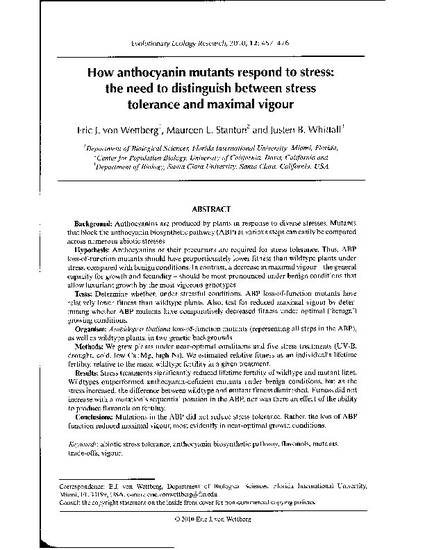
Background: Anthocyanins are produced by plants in response to diverse stresses Mutants that block the anthocyanin biosynthetic pathway (A BP) at various steps can easily be compared across numerous abiotic stresses Hypothesis: Anthocyanins or their precursors are required for stress tolerance. Thus, ABP loss-of-function mutants should have proportionately lower fitness than wildtype plants under stress, compared with benign conditions In contrast, a decrease in maximal vigour the general capacity for growth and fecundity should be most pronounced under benign conditions that allow luxuriant growth by the most vigorous genotypes Tests: Determine whether, under stressful conditions. ABP loss-of-function mutants have relatively lower fitness than wildtype plants Also, test for reduced maximal vigour by determining whether ABP mutants have comparatively decreased fitness under optimal ('benign') growing conditions. Organism: Arabidopsis thaliana loss-of-function mutants (representing all steps in the ABP), as well as wildtype plants. in two genetic backgrounds. Methods: We grew plants under near-optimal conditions and live stress treatments (UV-B, drought. cold, low Ca Mg, high Ni). We estimated relative fitness as an individual's lifetime fertility, relative to the mean wildtype fertility in a given treatment Results: Stress treatments significantly reduced lifetime fertility of wildtype and mutant lines Wildtypes outperformed anthocyanin-deficient mutants under benign conditions, but as the stress increased, the difference between wildtype and mutant fitness diminished. Fitness did not increase with a mutation's sequential position in the A BP, nor was there an effect of the ability to produce flavonols on fertility. Conclusions: Mutations in the ABP did not reduce stress tolerance Rather, the loss of ABP function reduced maximal vigour. most evidently in near-optimal growth conditions.
